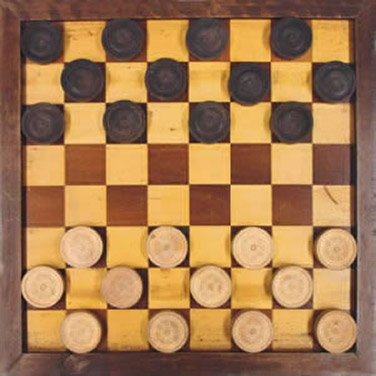Draughts

This game of strategy is for two people with twelve white and twelve black pieces placed exclusively on the black squares on a chess board. At the start, the players place their pieces on the first three rows, leaving the two rows in the middle of the board vacant. They move their pieces forwards diagonally on the black spaces. The aim is to get as many pieces to the final row while taking the opponent's pieces by jumping over them. If a piece reaches the final row, it is referred to as a "king", which is indicated by placing a piece that has already been taken on top of it. A king can move forwards and backwards.
The game is over when one of the players has lost all their pieces or is no longer able to move. Outside the German-speaking world, the rules vary and the game is also played on bigger boards (10x10 or 12x12 spaces).
History
It is very difficult to date draughts and its origins remain a mystery. One ancestor is believed to be the Arabic game "el-quirkat", which was introduced to Spain in the tenth century, where it became known by the name "alquerque". The Spanish King Alfons X describes it in detail in his book of games completed in 1283. Draughts is first thought to have appeared in its current form using a chess board in southern France or Spain in the late Middle Ages. Standardised rules were first established in the sixteenth century.
Mathematics
The first programme for American draughts (checkers) – one of the first ever game programmes for computers – was written by Arthur Samuel, a researcher at IBM, in 1952 and continuously improved until 1962. One distinctive feature was its ability to adapt the strategy to the opponent’s style of playing. Nowadays, there are programmes which no longer lose against human players.
In 2007, Jonathan Schaeffer proved that a game always ends in a tie, as long as both players play error-free. The necessary calculations for this finding, for which up to 200 computers were used, took eighteen years. The crucial step to this result was the creation of a database with all endgames with ten stones.Der entscheidende Schritt zu diesem Ergebnis ist das Anlegen einer Datenbank mit allen Endspielen mit 10 Steinen.